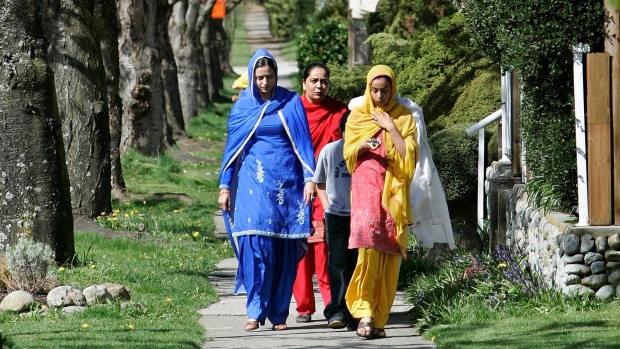
Living in a greener neighbourhood could lower risk of early death
Not just parks but also streetside trees and lawns could have health benefits, study suggests.
Trees stretching their canopies over city streets and grass tickling the sidewalk near your home are more than just pretty, they could actually be helping you live longer, a new study suggests.
Researchers at the University of New Brunswick used census and tax data to track 1.3 million non-immigrant Canadian adults living in the 30 biggest cities across the country, from Victoria to St. John’s, over 11 years starting in 2001. They measured the amount of greenery from trees, shrubs, grass and other plants within 250 metres (about two blocks) of the study subjects’ homes, using postal codes and satellite data. And they found that as the amount of greenery increased, people’s risk of premature death decreased “significantly” from natural causes.
“There was a lot bigger effect than I think any of us had been expecting,” said Dan Crouse, a health geographer and lead author of the studypublished this week in the journal The Lancet Planetary Health.
Using NASA’s Aqua satellite, the greenery was measured on a scale of 0 to 1. (Zero represented bare ground; 1 was complete coverage by dark green leafy plants.) The study found that each 0.15-point increase in greenness near the subjects’ homes was associated with an eight to 12 per cent decrease in the risk of death over the course of the study.
Crouse said the link between greenness and lower death rates remained even after researchers accounted for the effects of air pollution.
While previous studies have shown that exposure to green space and parks can improve mental health and in some cases physical health, the researchers say this is the first big study to show a clear link between green surroundings and a lower risk of premature death.
It also suggests that green spaces don’t have to be actual parks in order to have health benefits.
“What we’re able to show with this study is really just having trees around where people are living is really important,” Crouse said.
The study found that the positive effect of green surroundings was greater for people in middle age than in other age groups.
The effect was also greater among those with higher incomes and more education, and among men compared to women. The researchers aren’t sure why.
The study also couldn’t tell what kind of greenery was being measured, although trees gave a higher score than grass. Nor could it explain why exposure to greenery had that kind of effect — researchers didn’t know how much access people had to the green spaces or whether they were getting more exercise in greener areas, for example.
View of nature
But Crouse said there are benefits to living near green spaces such as golf courses even for people who don’t use them.
“That space is still representing an absence of traffic congestion, an absence of the noise and pollution from cars. It’s going to have a real cooling effect in an urban area,” he said. “Just having a view of nature from your window … can be restorative. There’s a lot of ways that the greenness could be benefiting your health.”
Dr. Gillian Booth is a researcher at St. Michael’s Hospital who recently found that people who live in more walkable city neighbourhoods have lower rates of diabetes and obesity. She says the design of Crouse’s study looks sound, and she has used similar techniques in her own work.
She added that the results make her wonder what it is about green surroundings that are lowering death rates, and what threshold of greenness is needed to get those health benefits.
“Where do you draw the line and say there’s insufficient green space? And how much should you invest in it?” she said. “I think this is really exciting work in that it raises these types of questions.”
The study, she added, highlights that the way we design our communities can have a profound influence on residents’ health: “The potential reach is huge in terms of the number of people who could be benefiting from these health effects.”
By Emily Chung, CBC News
Original article at: http://www.cbc.ca/news/health/green-spaces-lower-mortality
Photo credit: Lyle Stafford/Reuters








